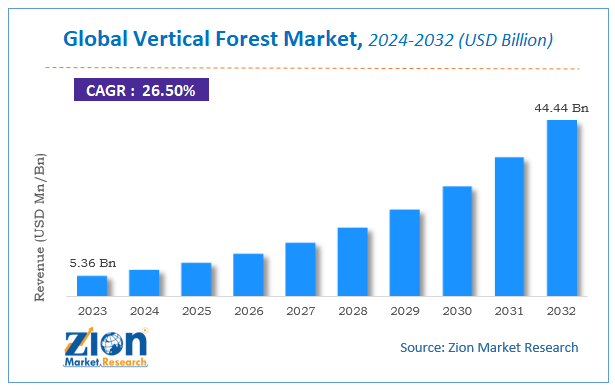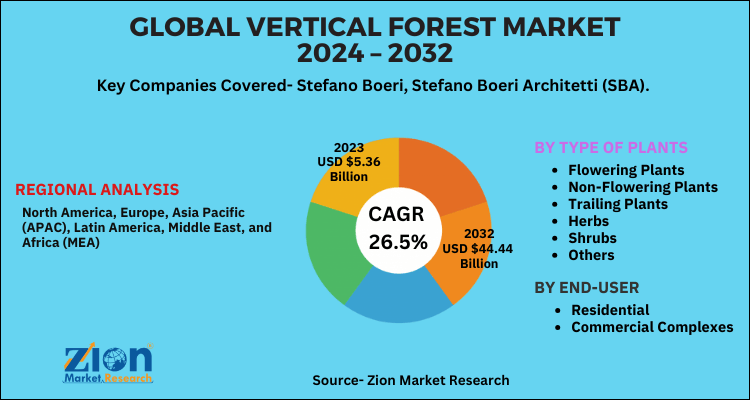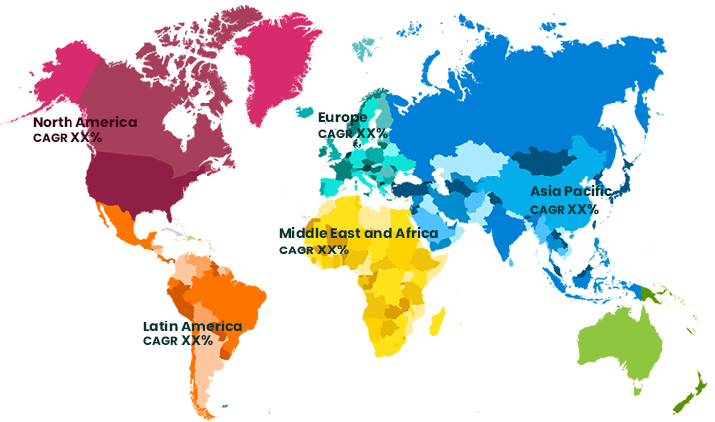Vertical Forest Market Size, Share, Trends, Forecast 2032

Vertical Forest Market - by Plants (Flowering Plants, Non-Flowering Plants, Trailing Plants, Herbs, Shrubs, Others), by End-User (Residential, Commercial Complexes), and by Region: Global Industry Perspective, Comprehensive Analysis and Forecast 2024 - 2032
| Market Size in 2023 | Market Forecast in 2032 | CAGR (in %) | Base Year |
|---|---|---|---|
| USD 5.36 Billion | USD 44.44 Billion | 26.5% | 2023 |
Vertical Forest Market Insights
According to a report from Zion Market Research, the global Vertical Forest Market was valued at USD 5.36 Billion in 2023 and is projected to hit USD 44.44 Billion by 2032, with a compound annual growth rate (CAGR) of 26.5% during the forecast period 2024-2032.
This report explores market strengths, weakness, opportunities, and threats. It also provides valuable insights into the market's growth drivers, challenges, and the future prospects that may emerge in the Vertical Forest industry over the next decade.
The Vertical Forest market is anticipated to register growth owing to tremendous focus of all the countries on sustainable development which focuses development of environment. Demand for smart cities across the globe is also driving the requirement of vertical forest.
Global Vertical Forest Market: Overview
In the district of Porta Nuova, Bosco Verticale, a pair of residential towers has more than 900 trees planted within the tower. This concept of planting trees in the towers and complexes is known as a vertical forest. The benefits of vertical forest are numerous to be precise it is the most efficient method to absorb the atmospheric carbon dioxide. It is estimated that around 20,000 trees can approximately absorb 44,000 pounds of carbon dioxide. The benefits obtained from the vertical forest such as producing humidity, absorbing CO2 and dust particles, and producing oxygen will increase its demand in the coming years.
Global Vertical Forest Market: Growth Factors
The homes of the future will be rapidly adopting the concept of a vertical forest. The major factor that is triggering the demand for the vertical forest market is the exponentially growing air pollution. The growing sales of the automobiles and the rapid industrialization have contributed to the rise in the air pollution in the world. Thus there is an immense pressure in finding out ways to control this atmospheric air pollution. Since one of the solutions to resolve air pollution is vertical forest, as trees are the efficient means of absorbing carbon dioxide, the popularity of the vertical forest market will increase in the future years. Other benefits of constructing vertical forests are it helps in keeping the indoor temperatures cool, reduces the intensity of sound pollution, and helps in filtering the dust particles. Factors such as housing shortages and the rapidly changing climatic conditions will favor the growth of the vertical forest market. The factor that may limit the growth of the market is the extra investment that is required for the regular maintenance of the plants.
Global Vertical Forest Market: Segmentation
The global vertical forest market can be segmented on the basis of plants and the end-user. Based on the type of plants, the vertical forest market can be divided into flowering plants, non-flowering plants, trailing plants, herbs, shrubs, and others. Based on the end-user, the market can be bifurcated into residential and commercial complexes.
Vertical Forest Market: Report Scope
| Report Attributes | Report Details |
|---|---|
| Report Name | Vertical Forest Market |
| Market Size in 2023 | USD 5.36 Billion |
| Market Forecast in 2032 | USD 44.44 Billion |
| Growth Rate | CAGR of 26.5% |
| Number of Pages | 110 |
| Key Companies Covered | Stefano Boeri, Stefano Boeri Architetti (SBA) |
| Segments Covered | By Type Of Plants, By End-User And By Region |
| Regions Covered | North America, Europe, Asia Pacific (APAC), Latin America, Middle East, and Africa (MEA) |
| Base Year | 2023 |
| Historical Year | 2018 to 2022 |
| Forecast Year | 2024 - 2032 |
| Customization Scope | Avail customized purchase options to meet your exact research needs. Request For Customization |
Global Vertical Forest Market: Regional Analysis
As vertical forest market is still an emerging market it is diversified in five major regions such as Asia Pacific, Europe, North America, and the Middle East and Africa. The first emergence of the vertical forest was in Milan, Italy. This concept was a huge hit thus, later on, this idea was adopted by several other regions. Europe is anticipated to lead the vertical forest market due to the increased investments in the infrastructure development. Asia Pacific vertical forest market is anticipated to grow at a rapid rate in the coming years. Nanjing, the city in China is in the process of building a vertical forest. This project will consist of two buildings that will have 1,100 trees and more than 2,500 other types of plants. It is expected that in the coming years, North America will witness a good growth rate in the vertical forest market.
Global Vertical Forest Market: Competitive Players
As the vertical forest market is still in the emerging phase the market players are involved are limited. The design for the vertical forest in Nanjing Towers was conceived by
- Stefano Boeri
- Stefano Boeri Architetti
- Waterfrom Design
- AteliersJean Nouvel
- Moshe Safdie Architects
Global Vertical Forest Market is segmented as follows:
By Type of Plants
- Flowering Plants
- Non-Flowering Plants
- Trailing Plants
- Herbs
- Shrubs
- Others
By End-User
- Residential
- Commercial Complexes
Global Vertical Forest Market: Regional Segment Analysis
-
North America
- The U.S.
- Europe
- The UK
- France
- Germany
- The Asia Pacific
- China
- Japan
- India
- Latin America
- Brazil
- The Middle East and Africa
What Reports Provides
- Full in-depth analysis of the parent market
- Important changes in market dynamics
- Segmentation details of the market
- Former, on-going, and projected market analysis in terms of volume and value
- Assessment of niche industry developments
- Market share analysis
- Key strategies of major players
- Emerging segments and regional markets
- Testimonials to companies in order to fortify their foothold in the market.
Table Of Content
Methodology
FrequentlyAsked Questions
The Vertical Forest market is anticipated to register growth owing to tremendous focus of all the countries on sustainable development which focuses development of environment. Demand for smart cities across the globe is also driving the requirement of vertical forest.
global Vertical Forest Market was valued at USD 5.36 Billion in 2023 and is projected to hit USD 44.44 Billion by 2032, with a compound annual growth rate (CAGR) of 26.5% during the forecast period 2024-2032.
As vertical forest market is still an emerging market it is diversified in five major regions such as Asia Pacific, Europe, North America, and the Middle East and Africa. The first emergence of the vertical forest was in Milan, Italy. This concept was a huge hit thus, later on, this idea was adopted by several other regions.
As the vertical forest market is still in the emerging phase the market players are involved are limited. The design for the vertical forest in Nanjing Towers was conceived by Stefano Boeri, Stefano Boeri Architetti (SBA) - the Milan based design firm.
Vertical Forest Market was valued at USD 5.36 Billion in 2023 and is projected to hit USD 44.44 Billion by 2032
HappyClients
Zion Market Research
Tel: +1 (302) 444-0166
USA/Canada Toll Free No.+1 (855) 465-4651
3rd Floor,
Mrunal Paradise, Opp Maharaja Hotel,
Pimple Gurav, Pune 411061,
Maharashtra, India
Phone No +91 7768 006 007, +91 7768 006 008
US OFFICE NO +1 (302) 444-0166
US/CAN TOLL FREE +1 (855) 465-4651
Email: sales@zionmarketresearch.com
We have secured system to process your transaction.
Our support available to help you 24 hours a day, five days a week.
Monday - Friday: 9AM - 6PM
Saturday - Sunday: Closed







